Course:Phys341 2020/Sung vowels
Spoken and Sung Vowels
One of the main differences in acoustic properties between speaking and singing is the treatment of vowels, sounds that are characterized by their voiced nature and open vocal tract configuration. Voicing refers to the articulatory process where vocal folds vibrate to produce sound. In regular speech there are both voiced and voiceless sounds. In singing, voiced sounds (such as vowels) dominate. Precise control of the vocal tract while producing these sounds is essential in creating the desired acoustics. Singers often slightly modify their vocal tract configuration in order to better produce vowels in song.

Human Vocal Tract
All vowels are produced with the pulmonic airstream mechanism, along with most consonants. This means that air from the lungs flows outwards through the vocal tract during the production of these sounds. As for the frequency, it is controlled by tension in the vocal folds. Figure 1 to the left displays the components of the human vocal tract.
Voicing, which is the source of sound production, provides a signal through modes of vibration by controlling the airstream. This then produces the fundamental frequency. Harmonics, which are whole number multiples of the fundamental frequency are also produced. Harmonics can be altered by changing the shape of the vocal folds, which then changes the pitch being created. Less closure in the vocal folds creates lower harmonics while more of a closure allows for both stronger and higher harmonics.
The natural resonance, or objects oscillating at a greater amplitude in response to certain frequencies, is based off of the size of the vocal tract. The natural resonant frequencies of the vocal tract filters what comes out of the source.
IPA Classification
The International Phonetic Alphabet (IPA) is an alphabetical system that provides standardized phonetic notation for all of the speech sounds or phonemes of spoken language. The IPA chart for consonants displays the manner and place of articulation for each consonant sound. The vowel IPA chart displays information concerning the height, backness, and roundedness of each vowel sound. A defining feature for vowels when compared to consonants is that there is no constriction in the airstream when produced. Vowel sounds tend to be louder than consonantal sounds
The height of vowels refers to where the tongue is positioned in the mouth during articulation. Vowel height can range from high to low, although they are often referred to as close (high), close-mid, open-mid, and open (low) vowels. For close vowels the tongue is positioned as close as possible to the roof of the mouth while still avoiding a constriction in the flow of air. In contrast, the tongue position for open vowels is as far as possible from the roof of the mouth, being lower in the mouth when compared to more close vowels.
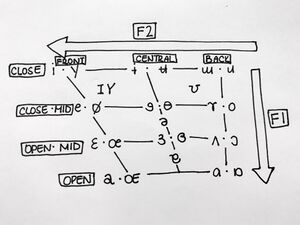
The backness of vowels refers to the horizontal positioning of the tongue during production. Vowel backness includes front, central, and back positioning placements. Front vowels are produced in the front of the mouth while back vowels are produced more towards the back.
Lastly, the roundedness of a vowel refers to the amount of rounding in the lips needed to produce the sound.
Note that only monophthongs are pictured.
[1] An IPA vowel chart with audio can be found here for further information.
Formant Properties of Vowels
A formant is concentrated acoustic energy that can be found at certain frequencies. By changing the size and shape of the vocal tract, one can change formants. Formants can be shifted by either constricting or expanding the vocal tract; constrictions decrease the frequency while expansions increase the frequency.
Each formant corresponds to a resonance in the vocal tract. In discussing vowels, the first three formants (F1, F2, F3) will be the main focus. The first formant pertains to how open the jaw is, or rather the distance between the tongue and the roof of the mouth. The height of the tongue, and therefore a vowel, is related to the F1 value. The second formant is dependent on the shape of the tongue body. The backness of a vowel relates to the F2 value. In relation to the IPA chart show in Figure 2, the horizontal dimension represents the F1 and the vertical dimension represents the F2. As F1 values increase the vowels become more open, and as F2 values increase the vowels have a more frontal placement. Figure 3 below shows approximate F1 and F2 values, measured in hertz, for some vowels. Lastly, the third formant concerns the position of the tongue tip.
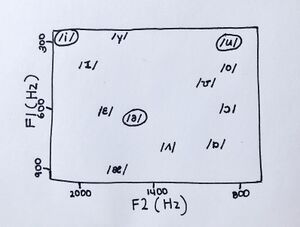
The Singing Formant
The Singing Formant is an additional vocal resonance that can be identified in singing. A concept developed by Johan Sundberg, this formant allows for added voiced and additional power in a singer's production. Sundberg associates lowering the larynx with the presence of this extra formant. It is absent in regular speech and the vocals of untrained singers, but it is possible to develop the Singing Formant with vocal training. The Singing Formant is found in the space between the third and fourth formants. When measuring average energy distribution and frequency in singing, a prominent peak around 3000Hz appears.
Vowels Visualized
Spectrograms, which display the spectrum of frequencies of a signal over time, were used to visualize the vowels 'i' (close front unrounded vowel), 'ə' (mid central vowel), and 'u' (close back rounded vowel). The frequency runs along the vertical axis and time runs along the horizontal axis. Formants are highlighted by red dots that identify concentrations of energy. The F1 is the red marking closest to the bottom of the image, the F2 is the middle marking, and the F3 is located near the top of the spectrogram. Additionally, a speech wave is shown over each spectrogram.
Vowels in Speech
Like musical instruments, the vocalization of a vowel has a fundamental mode present. This mode decides the repetition rate of the pattern, yet higher partials that correspond to formants dominate the pattern being created. Shown in Figures 4, 6, and 8 are the chosen vowels spoken in isolation. Figures 5, 7, and 9 are spectrograms of words that contain the vowel sound, with the clear bands being the formants of the vowel sound.
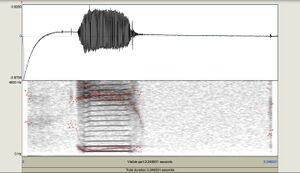 |
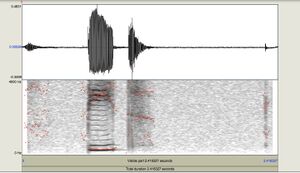 |
 |
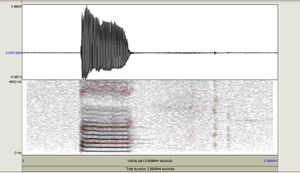 |
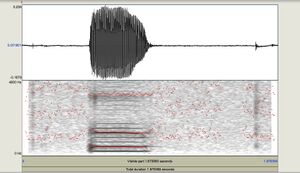 |
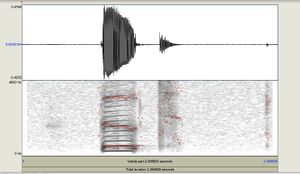 |
Vowels in Song
Vowel sounds are much easier to sing than consonants as they can be sustained as long as desired. Although consonants can contribute to a clearer diction in singing, vocalists are often more concerned with vowels and how they make variable vocalization possible. In singing there is much flexibility with the voice. Shown in Figures 10-12 are the vowel sounds sustained.
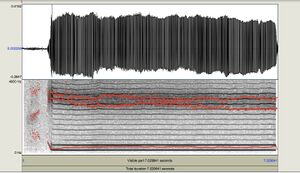 |
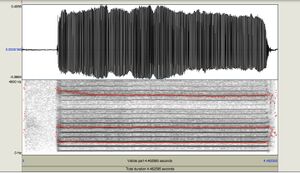 |
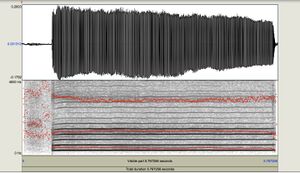 |
Sampling frequency for all spectrogram recordings: 44100Hz
The most notable difference between spoken and sung vowels can be found in the production of back vowels, which move to a slightly more forward position when sung. The F1 values seem to stay consistent whether they are spoken or sung for i and ə, whereas for u the formant is found lower on the spectrogram. The F2 values, however, move downwards on the spectrogram when sung, meaning the placement becomes slightly more frontal for each vowel. Additionally, when vowels are sung the bands appear darker on the spectrogram and each individual formant is more prominent in general.
References
[Fluent Forever]. (2012, May 6). Pronunciation Tutorial 3: English Vowels and the International Phonetic Alphabet. Retrieved from https://www.youtube.com/watch?v=eeaghqkLRi8
Story, B. The Vocal Tract in Singing. In The Oxford Handbook of Singing.
Sunberg's Singing Formant - Hyperphysics. Retrieved from http://hyperphysics.phy-astr.gsu.edu/hbase/Music/singfor.html
White, H.E. & White, D.H. (Dover Reprint 2014). Physics and Music: The Science of Musical Sound. Dover Publications.
Jenna Faykosh